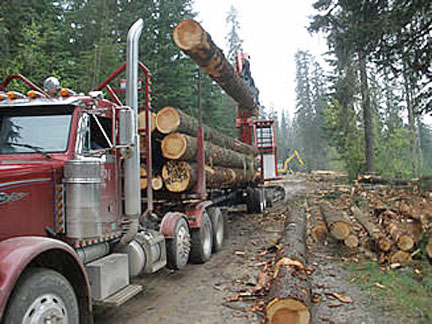| HOME | PROTECTION | NATURE | PLAN YOUR VISIT | FAQ | JOIN/DONATE | ABOUT |
 |
Stop wasting tax $$$ on money-losing timber salesLong ago, both sides of the timber wars recognized that the US Forest Service was losing money on timber sales. That is, taxpayers were paying more to sell timber from national forests than it received from the buyers. In 1981, the American Enterprise Institute (not known as a tree-hugging group) was arguing “Rational economic management would permit the production of more wood on less land, freeing large areas of national forest land for wilderness, recreation, and other purposes.” https://www.aei.org/articles/wasting-our-national-forests-how-to-get-less-timber-and-less-wilderness-at-the-same-time/ The problem is getting worse. In 2016, the Natural Resource Economics organization found that “below-cost timber sales are far more severe than those of the 1990s.” https://nreconomics.com/reports/2016-07-28_16-04_OR_Below-Cost.pdf Yet such below-cost timber sales continue. When we plea for more recreation projects, we are told “Good idea. We don’t have the money.” We are even asked to donate to such projects. This, to us, a tiny non-profit, from the Federal Government. As we focus on recreation facilities and programs, we are learning that the bulk of Forest Service recreation facilities rely on grants and volunteer efforts like trail building and maintenance for their existence. It is time for the Forest Service to stop losing money on preparing, monitoring and selling public trees at a loss, and to shift those $$$ to recreation. The Forest Service can better fulfill its mission of “serving the people” by improving recreation facilities, not subsidizing timber industry resources in the name of job creation. That defies logic while the mills are eliminating those very jobs through automation. |
 |
How much taxpayer money is being lost on this sale? |
READ THIS! |
 |
The timber wars were inevitable. in fact, the Spotted Owl just may have saved the timber industry. As the industry marched across the continent, looking only for profit, it finally came to the end of the road, so to speak. Until the 1970s, the industry’s attempt to convert the forests to monoculture tree farms, including public lands, was succeeding. Demonizing old growth as biological deserts, spraying herbicides everywhere to “suppress” “competing “ vegetation, maintaing mills to handle large old growth trees, all to make trees into mere products such as toilet paper. Given this trajectory,all the old growth would eventually be gone. Mills would have needed to be retooled to accomodate smaller, plantation trees. Guess what? After the spotted owl put so many big old trees off limits, the mills retooled. Not only that, in the process, the mills were automated, putting many workers out of their jobs. Turns out, the Spotted Robot did the job the industry claimed the owl would do. Instead, the owl is surviving (barely), the fishing industry may even be revived, all because the public forest managers are finally seeing the forest beyond the trees. How did this happen? This book tells the story in all the details of the rising influence of science, public opinion and the resulting political actions. But it is not over. The timber wars will continue untill all of the old school industry leaders leave the scene, the sympathetic bureaucrats ascend to top leadership and the old school academics retire. So, what happened to the rural northwest economy? This book cites studies that answer that question. Employment shifted towards urban areas. Small rural towns suffered. Federal employment dropped and those workers moved on or retired. Sounds bad, and, in many ways, it was. Missing from this book (beyond it’s scope?) is a comparison to the economic impact on midwestern and eastern communities as the old growth industry moved west, leaving those regions behind. It can only be speculated, but economic turmoil always happens when communities rely on limited resources that eventually run out. For tree-hugging nerds like me, this fascinating story gives an in-depth look at all the influencers who made this happen, and the winding path, setbacks and compromises that gave us the Northwest Forest Plan. A real page-turner. Just as the Northern Spotted Owl relies on the natural forest, we rely on the Northwest Forest Plan (NWFP) to protect the natural forest. The NWFP was developed to protect the owl and all the other critters that live in our forest - marbled murrelet, northern flying squirrel, red-backed vole, all those salmon species and all the rest. As such, it was a result of considerable compromise and is currently being considered for amending. This book was written by the leading authors of the NFP (Norm Johnson, Jerry Franklin and Gordon Reeves). It also points out the weaknesses of the plan that need to be corrected in the upcoming amendment process. If you want to influence the management of our public forests, this book is a must-read for you to learn all the nuances of that management:
|
Douglas-fir National Monument
|
 |
| Healthy soil supports a healthy forest Credit: US Forest Service |
GET OUT
|
|
For more such ski trails, go to
|

Prez sez:by David Stone, President, FDFNM |
|
Welcome our newest Advisory Board member, Woody Jackson. Known to his friends as “Woody Debris”, he has been a long time advocate for the forest in the Breitenbush section of our Monument proposal. Years ago, he put down roots in that area and has been committed to protection of that forest ever since. Currently, he is President of Friends of the Breitenbush Cascades, serves on the North Santiam Watershed Council and is a Volunteer Team Leader for SOLVE and Cascade Volunteers. We look forward to benefiting from his historical knowledge and his ongoing commitment to protecting the forest. |
 |
"Look deep into nature and you will understand everything better" |
| Contact us: |
|
by email |
Mail: | Friends of Douglas-fir National Monument P.O. Box 7174 Springfield, OR 97475 |